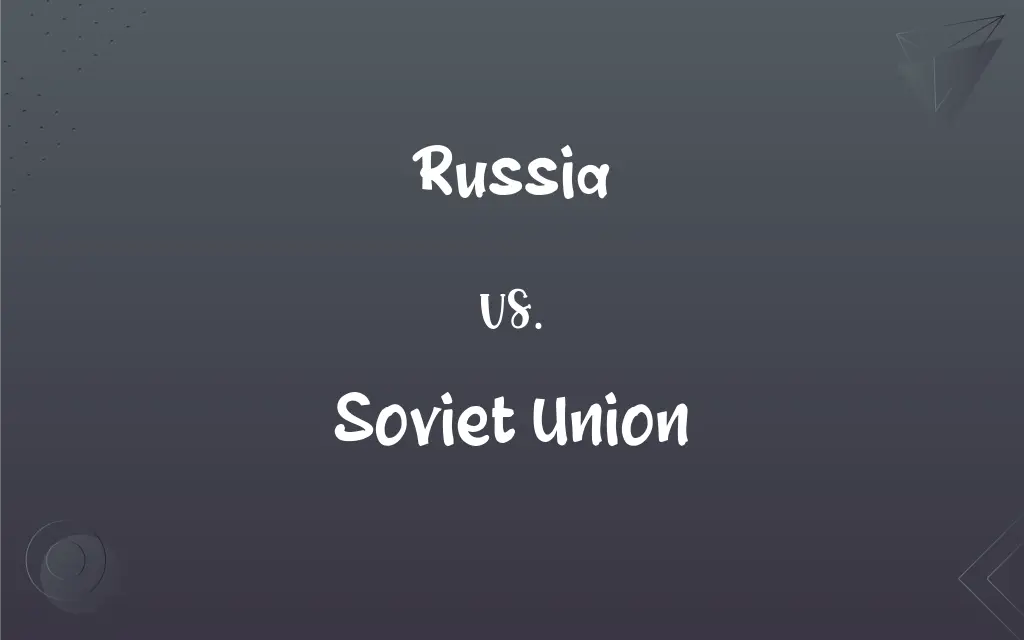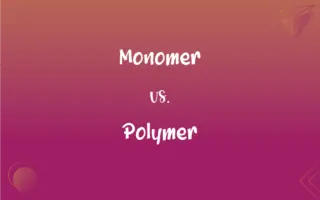Russia vs. Soviet Union: What's the Difference?
Edited by Aimie Carlson || By Harlon Moss || Updated on October 10, 2023
Russia is a country in eastern Europe and northern Asia, while the Soviet Union was a federation of socialist republics led by Russia that existed from 1922 to 1991.

Key Differences
The term Russia generally refers to the largest country in the world, known for its vast territorial expanse, rich history, and significant influence in global affairs. Russia, as a nation, boasts a profoundly rich cultural, historical, and geopolitical narrative that has evolved across centuries, encompassing tsarist regimes, revolutions, and various socio-political transformations. Russia inherently carries the legacy of various epochs, reflecting not only in its political and social structure but also within its cultural and historical consciousness, extending well beyond its Soviet past.
Contrastingly, the Soviet Union, officially the Union of Soviet Socialist Republics (USSR), was a federal socialist state in northern Eurasia that existed from 1922 to 1991. The Soviet Union was not a singular entity but a federation, consisting of multiple socialist republics with Russia as its largest and most influential member. The formation, existence, and dissolution of the Soviet Union encapsulate a crucial period that was shaped by ideologies of socialism and communism, impacting not only the constituent republics but also global politics and relations significantly.
Russia, in contemporary contexts, pertains to the country that emerged post the dissolution of the Soviet Union in 1991, navigating through the complexities of its newfound identity and the geopolitical and economic realities of the post-Cold War era. Today's Russia, led from the city of Moscow, encompasses a wide array of federal subjects and maintains a form of governance and international policy distinct from its Soviet predecessor. As a nation, it straddles continents, histories, and ideologies, reflecting an amalgam of its storied past and evolving future.
The Soviet Union, on the other hand, embodied a specific historical and political chapter, markedly different from pre-revolutionary Russia and distinctly separate from the modern Russian Federation. Led ideologically by principles of Marxism-Leninism, the Soviet Union sought to establish and promote a socialist order, positioning itself as a counterbalance to capitalist powers, and playing a pivotal role in global events such as the Cold War. The Soviet era witnessed extensive state control over various aspects of life, including economy, politics, and media, profoundly shaping the experiences and histories of its diverse populace.
Thus, while Russia and the Soviet Union are intrinsically linked, recognizing them as distinct entities, defined by differing political structures, ideologies, and historical timelines, is crucial. Russia, whether in its tsarist, Soviet, or contemporary avatar, presents one aspect of a multifaceted history and identity. Simultaneously, the Soviet Union symbolizes a specific ideological and historical period that has undeniably influenced, but does not solely define, the trajectory of the Russian nation.
ADVERTISEMENT
Comparison Chart
Time Period
Before 1922, and post-1991 to present
1922-1991
Political Structure
Currently a federal semi-presidential republic
Federative socialist republic
Ideological Basis
Varied across different eras
Primarily Marxist-Leninist
Geopolitical Context
Existing nation with historical & modern contexts
Specific historical and geopolitical entity
Global Influence
Influential in varying capacities across epochs
Predominant Cold War actor
ADVERTISEMENT
Russia and Soviet Union Definitions
Russia
Russia is the largest country geographically in the world.
Russia spans two continents, Europe and Asia, providing a vast and varied landscape.
Soviet Union
The Soviet Union was a federative socialist state in Eurasia.
The Soviet Union was established in 1922, following the Russian Civil War.
Russia
Russia possesses significant geopolitical influence globally.
Russia, as a permanent member of the UN Security Council, plays a pivotal role in global affairs.
Soviet Union
It was a significant global power during the 20th century.
The Soviet Union was a primary actor in the Cold War against the United States.
Russia
It's a nation with a rich and diverse historical tapestry.
Russia’s history encompasses periods of monarchies, communism, and a modern federation.
Soviet Union
The Soviet Union dissolved in 1991, splintering into multiple independent nations.
The dissolution of the Soviet Union marked the end of the Cold War era.
Russia
It's a country known for its contributions to arts, science, and global culture.
Russia has produced illustrious figures like Dostoevsky in literature and Tchaikovsky in music.
Soviet Union
It comprised fifteen republics, including Russia as its largest and most influential member.
The Soviet Union included nations such as Ukraine, Belarus, and Uzbekistan.
Russia
A country of Europe and Asia.
Soviet Union
The state operated on Marxist-Leninist principles.
The Soviet Union emphasized a centrally planned economy and collectivization.
Russia
A former communist country in eastern Europe and northern Asia; established in 1922; included Russia and 14 other soviet socialist republics (Ukraine and Byelorussia an others); officially dissolved 31 December 1991
Russia
Formerly the largest Soviet Socialist Republic in the USSR occupying eastern Europe and northern Asia
Russia
A former empire in eastern Europe and northern Asia created in the 14th century with Moscow as the capital; powerful in 17-18th centuries under Peter the Great and Catherine the Great when Saint Petersburg was the capital; overthrown by revolution in 1917
Russia
A federation in northeastern Europe and northern Asia; formerly Soviet Russia; since 1991 an independent state
Russia
Russia navigates through a modern era defined by various socio-political and economic dynamics.
Russia’s economy, influenced by energy exports and international relations, is a key global player.
FAQs
What is the capital of Russia?
Moscow is the capital of Russia.
Which ideology did the Soviet Union propagate?
The Soviet Union propagated Marxist-Leninist ideology.
Was Russia always an independent country?
No, Russia was part of the Soviet Union from 1922 to 1991.
Is Russian culture influenced by its Soviet past?
Yes, contemporary Russian culture is significantly influenced by its Soviet past.
Did Russia have tsars during the Soviet Union period?
No, the tsarist rule ended before the establishment of the Soviet Union.
Does Russia follow the same ideology today as the Soviet Union did?
No, contemporary Russia does not follow Marxist-Leninist ideology, adopting different political and economic structures.
What significant global conflict was the Soviet Union involved in after WWII?
The Soviet Union was a central player in the Cold War post-WWII.
Who is a globally renowned Russian writer?
Leo Tolstoy, author of "War and Peace," is a globally renowned Russian writer.
What is Russia known for geographically?
Russia is known as the largest country in the world, spanning Europe and Asia.
What significant event happened in Russia in 1917?
In 1917, the Russian Revolution occurred, leading to the eventual formation of the Soviet Union.
When did Russia host the Olympic Games?
Russia hosted the Summer Olympics in 1980 (as the Soviet Union) and the Winter Olympics in 2014.
Was the Soviet Union a member of the United Nations?
Yes, the Soviet Union was a founding member of the United Nations.
What is the official language of Russia?
The official language of Russia is Russian.
How many republics constituted the Soviet Union?
The Soviet Union was constituted of fifteen republics.
Who was the last leader of the Soviet Union?
Mikhail Gorbachev was the last leader of the Soviet Union.
Did the Soviet Union participate in World War II?
Yes, the Soviet Union was a major Allied power in World War II.
Which ocean is Russia not bordered by?
Russia is not bordered by the Indian Ocean.
When did the Soviet Union officially dissolve?
The Soviet Union officially dissolved on December 26, 1991.
What led to the formation of the Soviet Union?
The Soviet Union formed after the Russian Revolution and Civil War, establishing a socialist state.
What currency is used in Russia today?
Russia uses the Russian Ruble (RUB) as its currency.
About Author
Written by
Harlon MossHarlon is a seasoned quality moderator and accomplished content writer for Difference Wiki. An alumnus of the prestigious University of California, he earned his degree in Computer Science. Leveraging his academic background, Harlon brings a meticulous and informed perspective to his work, ensuring content accuracy and excellence.
Edited by
Aimie CarlsonAimie Carlson, holding a master's degree in English literature, is a fervent English language enthusiast. She lends her writing talents to Difference Wiki, a prominent website that specializes in comparisons, offering readers insightful analyses that both captivate and inform.
































































